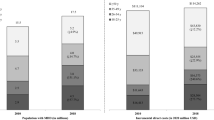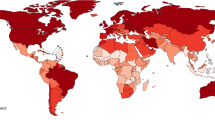Abstract
Aim: To estimate psychiatric and somatic morbidity in a nation-wide prison population, as inferred from detailed medication sheets. Method: Medication sheets from 37 prisons, covering 90% of the Norwegian prison population, were collected and examined by experienced clinicians. All inmates on medication were assigned best-estimate psychiatric and/or somatic diagnoses according to the International Classification of Primary Care diagnostic system. Results: Among the 2617 inmates 919 (35%) had psychiatric disorders, as estimated by our methodology. Depressive disorders (11%) and sleep disorders (11%) were most prevalent. Twenty-six inmates (1%) were prescribed medication indicative of affective psychosis and an additional 77 (3%) received anti-psychotic drugs in doses indicating other psychotic disorders, bringing the sum total of psychosis up to 103 (4%). A total of 848 inmates (32%) were estimated to suffer from somatic disorders. Various pain conditions were prevalent (11%) in addition to obstructive airway diseases and asthma (4%). Both psychiatric and somatic disorders were more prevalent in female prisoners. Conclusion: This study has demonstrated high psychiatric and somatic morbidity in a nation-wide population of prison inmates receiving adequate health services. As the morbidity estimates are inferred from prescription drug use they must be interpreted with caution. However, we do believe that our study, utilizing this unconventional but readily available source of information, has yielded valuable knowledge regarding the physical and mental health of a nation-wide prison population.
Similar content being viewed by others
Abbreviations
- ICPC-2:
-
International Classification of Primary Care diagnostic system, 2nd Edition
- NSAIDs:
-
Non-Steroidal Anti-Inflammatory Drugs
- NOS:
-
Not Otherwise Specified
- PRN:
-
(Pro Re Nata) medication taken ‘as needed’
Reference
S Fazel J Danesh (2002) ArticleTitleSerious mental disorder in 23000 prisoners: a systematic review of 62 surveys Lancet 359 545–550 Occurrence Handle11867106
CH Lindquist CA Lindquist (1999) ArticleTitleHealth behind bars: utilization and evaluation of medical care among jail inmates J Community Health 24 285–303 Occurrence Handle10.1023/A:1018794305843 Occurrence Handle10463472
J Baillargeon SA Black J Pulvino K Dunn (2000) ArticleTitleThe disease profile of Texas prison inmates Ann Epidemiol 10 74–80 Occurrence Handle10.1016/S1047-2797(99)00033-2 Occurrence Handle10691060
M Earthrowl J O’Grady L Birmingham (2003) ArticleTitleProviding treatment to prisoners with mental disorders: development of a policy. Select literature review and expert consultation exercise Br J Psychiatry 182 299–302 Occurrence Handle10.1192/bjp.182.4.299 Occurrence Handle12668404
J Reed M Lyne (1997) ArticleTitleThe quality of health care in prison: results of a year’s programme of semistructured inspections BMJ 315 1420–1424 Occurrence Handle9418090
PM Brinded AI Simpson TM Laidlaw N Fairley F Malcolm (2001) ArticleTitlePrevalence of psychiatric disorders in New Zealand prisons: a national study Aust N Z J Psychiatry 35 166–173 Occurrence Handle10.1046/j.1440-1614.2001.00885.x Occurrence Handle11284897
WONCA International Classification Committee. International classification of primary Care ICPC-2. 2nd edn. Oxford: Oxford University Press, 1998
E Kringlen S Torgersen V Cramer (2001) ArticleTitleA Norwegian psychiatric epidemiological study Am J Psychiatry 158 1091–1098 Occurrence Handle11431231
T Maden M Swinton J Gunn (1994) ArticleTitlePsychiatric disorder in women serving a prison sentence Br J Psychiatry 164 44–54 Occurrence Handle8137109
JA Costae Silva M Chase N Sartorius T Roth (1996) ArticleTitleSpecial report from a symposium held by the World Health Organization and the World Federation of Sleep Research Societies: an overview of insomnias and related disorders – recognition, epidemiology, and rational management Sleep 19 412–416 Occurrence Handle8843532
BS Elger (2004) ArticleTitlePrevalence, types and possible causes of insomnia in a Swiss remand prison Eur J Epidemiol 19 665–677 Occurrence Handle10.1023/B:EJEP.0000036805.58237.e3 Occurrence Handle15461198
PS Bakke V Baste R Hanoa A Gulsvik (1991) ArticleTitlePrevalence of obstructive lung disease in a general population: relation to occupational title and exposure to some airborne agents Thorax 46 863–870 Occurrence Handle1792631
M Osborn T Butler PD Barnard (2003) ArticleTitleOral health status of prison inmates – New South Wales, Australia Aust Dent J 48 34–38 Occurrence Handle14640155
JM Mixson HC Eplee PH Feil JJ Jones M Rico (1990) ArticleTitleOral health status of a federal prison population J Public Health Dent 50 257–261 Occurrence Handle2391675
I Sommers DR Baskin (1991) ArticleTitleAssessing the appropriateness of the prescription of psychiatric medications in prison J Nerv Ment Dis 179 267–273 Occurrence Handle2022954
J Baillargeon SA Black S Contreras J Grady J Pulvino (2001) ArticleTitleAnti-depressant prescribing patterns for prison inmates with depressive disorders J Affect Disord 63 225–231 Occurrence Handle11246100
BS Elger M Bindschedler C Goehring SA Revaz (2004) ArticleTitleEvaluation of drug prescription at the Geneva prison’s outpatient service in comparison to an urban outpatient medical service Pharmacoepidemiol Drug Saf 13 633–644 Occurrence Handle15362087
Act of 19 November 1982 No.66 Relating to Municipal Health Services. In: The Norwegian Law Compendium. Gjoevik, Norway: The Faculty of Law, University of Oslo, 2002, pp. 1372–1381
Act of 30 March 1984 No. 15 Relating to the Public Supervision of Health Services. In: The Norwegian Law Compendium. Gjoevik, Norway: The Faculty of Law, University of Oslo, 2002, p. 1417.
Author information
Authors and Affiliations
Corresponding author
Rights and permissions
About this article
Cite this article
Kjelsberg, E., Hartvig, P. Can morbidity be inferred from prescription drug use? Results from a nation-wide prison population study. Eur J Epidemiol 20, 587–592 (2005). https://doi.org/10.1007/s10654-005-8156-9
Accepted:
Issue Date:
DOI: https://doi.org/10.1007/s10654-005-8156-9




